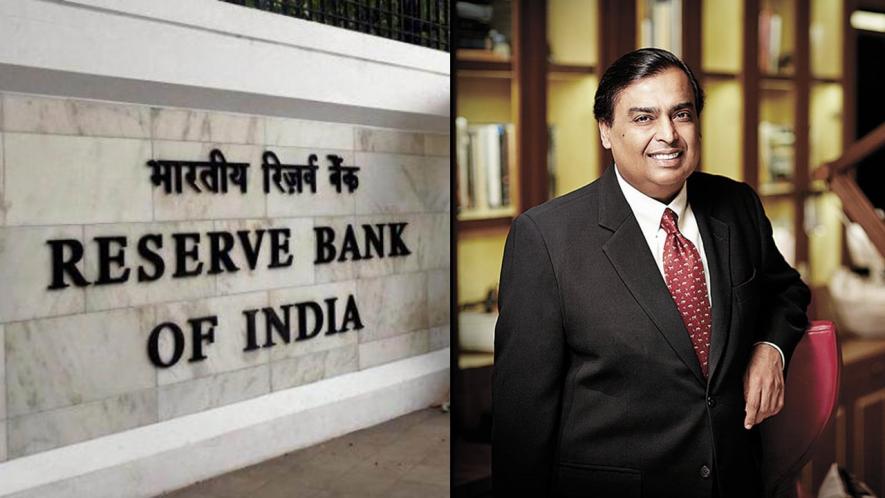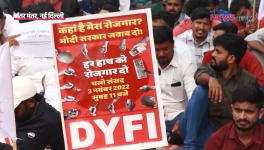RBI Hike in Banks’ Group Exposure Limit to Benefit Reliance

Gurugram/Mumbai: “Today I am both delighted and humbled to announce that we have fulfilled our promise to the shareholders by making Reliance net debt-free much before our original schedule of 31st March 2021. Exceeding the expectations of our shareholders and all other stakeholders, again and yet again,” said Mukesh Ambani, Chairman and Managing Director of Reliance Industries Limited (RIL) on June 19, as the company’s stock price hit a record high.
He added: “….on the proud occasion of becoming a net debt-free company, I wish to assure them (shareholders) that Reliance in its Golden Decade will set even more ambitious growth goals, and achieve them.”
Over the past few weeks, Newsclick has documented and analysed how India’s biggest private corporate entity has benefitted from changes in government policies. In this, the fifth article in the series, the implications of a recent policy change by the Reserve Bank of India (RBI) are examined.
On May 22, the country’s central bank and apex monetary authority hiked the group exposure limit of banks to a single corporate group from 25% to 30% till June 30, 2021. The limit will be restored to 25% after the deadline unless the RBI decides otherwise. The group exposure limit determines the maximum amount a bank can lend to one corporate group, ostensibly to prevent loan repayment troubles in one group entity spilling over to the entire group leading to systemic risks for banks.
The Governor of the RBI, Shaktikanta Das, stated in his public speech: “In view of the current difficulty in raising resources from capital markets, the group exposure limit of banks is being increased from 25% to 30% of eligible capital base, for enabling corporates to meet their funding requirements from banks.”
The decision by the RBI implies a policy direction that is opposite to the recommendations that had been made to protect the banking system from growing stacks of bad debt in the form of non-performing assets (NPAs). While increasing the risk to banks, the hike in the group exposure limit will benefit some of India’s largest corporate groups, such as the Reliance group headed by India’s richest man, Mukesh Ambani.
The ability to raise more debt from the banking system comes at a crucial time for Reliance as it seeks to execute a pivot away from its core business areas, such as petrochemicals and power, to a telecommunications and mobile internet-driven retail, digital banking, and media ecosystem as its main revenue generator.
With a flush of investments in Jio Platforms, a subsidiary of Reliance Industries Limited (RIL) that houses the groups’ digital and telecom businesses arriving simultaneously with India’s biggest ever-rights issue, aimed at paying off the high debt burden built up on its legacy businesses, the all-India lockdown caused by the COVID-19 pandemic is emerging as a turning point of sorts for the Mukesh Ambani-led conglomerate. The RBI’s hike in group exposure limit, coming at a crucial juncture, will enable further growth for one of India’s mostly highly indebted corporate groups–– the Reliance group.
What the Parliamentary Committee Said
On January 3, 2019, the 31-member, multi-party Parliamentary Standing Committee on Finance’s 88-page report on India’s banking sector was presented to both the Lok Sabha and the Rajya Sabha. The committee, headed by M Veerappa Moily, had presented its report earlier, on August 31, 2018, to the Speaker of the Lok Sabha. Here are excerpts from the report relating to group exposure of banks:
“Currently, the concerns arising from concentration risk due to banks’ exposures towards their single and group borrowers are addressed by way of limits on such exposures. However, in order to converge the current prudential norms on “banks’ exposures” with the BCBS (Basel Committee on Banking Supervision) standards on ‘Supervisory framework for measuring and controlling large exposures’, RBI has issued the final guidelines on ‘Large Exposures Framework’ vide circular dated December 1, 2016. The Framework would be fully applicable by January 1, 2019.”
(The BCBS is an international committee of representatives of banking supervisory authorities that was established by governors of central banks under the aegis of the Bank for International Settlements located at Basel, Switzerland.)
The parliamentary committee’s report added: “Under the framework, the LE (large exposure) limit in respect of each counter party and group of connected counter parties, under normal circumstances, will be capped at 20 percent and 25 percent respectively of the eligible capital base i.e. Tier 1 capital of the bank as against ‘Capital Funds’ at present.”
In the section titled, ‘Guidelines on Framework for Enhancing Credit Supply for Large Borrowers Through Market Mechanism’, the report stated: “With a view to mitigating the risk posed to the banking system on account of overleveraging of a single corporate, RBI has issued guidelines on Framework for enhancing Credit Supply for Large Borrowers through Market Mechanism vide circular dated August 25, 2016. The Framework has come into effect from the financial year 2017-18 and will be applicable to all banks in India as well as branches of Indian banks abroad.
“Under the Framework, incremental bank credit to borrowers having aggregate sanctioned fund-based credit limits (ASCL) in excess of a threshold, from the banking system, will invite additional risk weights and higher standard asset provisions. This should encourage larger borrowers to access more of their financing needs from market sources, e.g. bond issuance.”
Bankers’ React to RBI Decision
Responding to the May 22 policy change by the RBI enhancing the group exposure limit of banks from 25% to 30%, Thomas Franco, former all-India general secretary of the All India Bank Officers Confederation, pointed out: “This decision is only helpful to highly exposed corporate groups like the Adanis and Ambanis.”
A top source in the public sector State Bank of India (SBI), the country’s largest bank, concurred. Speaking to one of the authors of this article on condition of anonymity, he said: “Exposure limits of banks to corporate groups should be in the public domain, just as industry-wise exposure limits are. There should also be greater clarity on the criteria for including an entity as a part of a group, especially in the case of entities where the promoters may have a minority shareholding but a controlling interest. The shareholding threshold limits for inclusion of an entity in a group should be clearly stated, as well as what constitutes ‘controlling interest’ for multi-layered entities in a group that has complex cross-holdings. The Reliance group can be categorised as one such group.”
The source added: “Besides Reliance, another beneficiary of the RBI’s move to increase group exposure limits for banks could be the Adani group. I doubt if any other group would have breached SBI’s group exposure limits.”
Vishwas Utagi, former vice president of the All India Bank Employees Federation (AIBEF), told Newsclick: “The RBI has given banks guidelines and criteria to determine whether or not particular entities should be part of a group. The managements of individual banks then work out group exposure limits based on these guidelines. There is a certain discretion involved in how bank managements interpret the RBI’s guidelines and criteria to decide on whether a particular entity should be considered part of a group or not.”
An analyst added off the record: “The government, the banks and corporate honchos play this cat-and-mouse game and structure what is euphemistically called ‘off balance sheet’ borrowing through associate entities that are tenuously linked to the parent entity–say, the group’s flagship or a wholly-owned subsidiary––through complex and convoluted multi-layered cross-holdings of equity shares. It is often not a simple case of an entity holding 51% or 26% of the equity of another entity.”
This person stated: “What is also not clear is who is supposed to responsible and accountable for raising an alert when a corporate group is about to breach––or has breached––the group exposure limit applicable to a specific bank. Is it the responsibility of the promoters of the group or the management of a bank? Or has this issue of accountability been kept deliberately fuzzy?
On June 3, one of the authors of this article sent an email to Rajnish Kumar, Chairman, State Bank of India, with a copy marked to the officer handling the bank’s external communications. Among the questions asked, were the following:
- Before the (May 22) announcement by the RBI, was the SBI’s exposure to any corporate group already at the prior limit of 25% of eligible capital base? If so, to which corporate group/s was SBI exposed at 25% or more?
- What is the SBI’s exposure to the Reliance group of companies headed by Mukesh D Ambani?
- It can be argued that the single biggest beneficiary of the RBI’s decision to increase banks’ group exposure limits would be the corporate group led by Reliance Industries Limited (RIL). What are your comments?
Till the time of publication, no response had been received from the SBI; the article will be updated as and when a response is received.
Another analyst, also speaking on condition of anonymity, said that while the overall group exposure of the country’s largest bank (SBI) to the country’s biggest corporate entity (RIL), is not known, “there is a possibility that the SBI has on occasions breached the group exposure limit relating to Reliance and since the facts are not in the public domain, we can at best speculate.”
He calculated that the SBI’s loss in Alok Industries––which is now an ‘associate” company of the Reliance group––is approximately Rs 3,000 crore. The bank’s loss in Reliance Communications is around Rs 4,000 crore and the SBI’s exposure to Reliance Jio is estimated to be in the region of Rs 7,000 crore though, of course, as the analyst pointed out, the Reliance Jio account is not an NPA (non-performing asset or bad loan) and its debt would get pared down considerably by the expected infusions of investments of equity capital that have been recently announced.”
Devidas Tuljapurkar, former joint secretary of AIBEF, put it even more forcefully: “Along with Reliance group, there are several large corporate groups that are similarly close to the extant group exposure limits. The decision to raise group exposure limit will be helpful to them, if it is to enable them to raise capital. The Prime Minister stated on television that the pandemic presents an opportunity for us all, but it seems it has come as an opportunity for the big corporates.”
Utagi, former vice president of the AIBEF, pointed out how even a government decision ostensibly targeted at aiding small businesses would also help the Reliance group: “Recently the government has started an emergency credit line guarantee scheme for MSMEs (Micro, Small and Medium Enterprises). Though Reliance group is not an MSME, hundreds of SMEs that are Reliance’s subsidiaries or associates would benefit from the move.”
‘Biggest Corporate Bound to be Biggest Beneficiary’
A former SBI managing director, speaking on condition of anonymity, disagreed with the others quoted, saying there was nothing unusual about Reliance group benefiting from the RBI’s decision.
“If group exposure limits are made public, it can be construed as a breach of confidentiality in the relationship between a bank and its client. The debates on what should be the criteria for inclusion of an entity in a group or a conglomerate has been going on for many years in India––and these debates remain inconclusive. For instance, when in the 1990s, the SBI had sought to include the Associated Cement Companies (ACC) as part of the Tata group for determining group exposure limits, the company objected strenuously.”
The former MD of the SBI added: “If Reliance is the biggest beneficiary of the RBI’s decision to increase group exposure limits, why should that surprise you? After all, RIL is the biggest corporate entity in the private sector in the country.
He pointed out that in the past as well, the government has tailored rules to favour the Reliance group. “For instance, in May 1985, the government opened a short window of opportunity for Reliance to undertake imports of PTA (purified terephthalate acid), an intermediary product used for the manufacture of polyester fibre, before changing the customs duty structure. So what’s new?” he asked.
One of the authors sent the following questionnaire to former RBI Governor Raghuram Rajan on June 16, seeking his comments for this article. No response was received at the time of going for publication. Besides seeking his comments on the opinions expressed by various individuals quoted, replies were sought to the following questions from the former RBI Governor:
1. It can be argued that the only beneficiaries of the decision will be highly leveraged corporate groups such as the Reliance group and its net exposure is understood to have already exceeded the earlier group exposure limits. I seek your comments.
2. During your tenure as Governor of the RBI, you had proposed that a ceiling be set on exposure to individual corporate groups to the extent of Rs 10,000 crore. A similar recommendation had been made by the Parliamentary Standing Committee on Finance. What was your reasoning behind this proposal?
3. After your tenure as RBI Governor got over, the recommended ceiling on group exposure has not been put in place, and now the RBI has recommended banks take on an even higher exposure. I seek your comments.
The hike in group exposure limit came at a time when multiple other government decisions seemed to favour the Reliance group’s endeavours. In previous articles, these authors have covered how various decisions by the RBI, the Securities and Exchange Board of India and the Union Ministries of Finance and Corporate Affairs helped the group conduct a Rs 53,000 crore fund-raising rights issue. Each of these decisions was ostensibly aimed to help the economy on account of the COVID-19 induced lockdown.
(To be continued.)
This is the fifth article in the series. Links to the first four articles are given below:
Read Also: Ambani Family Reshuffled Shares in Reliance Industries Before Facebook Deal
Read Also: Is Reliance’s Rights Issue Over-Valued?
Read Also: Did the Government Help Reliance Industries Raise Rs 53,000 crore?
Read Also: Foreign Investments in Reliance Jio: A Security Concern?
The authors are independent journalists.
Get the latest reports & analysis with people's perspective on Protests, movements & deep analytical videos, discussions of the current affairs in your Telegram app. Subscribe to NewsClick's Telegram channel & get Real-Time updates on stories, as they get published on our website.
























